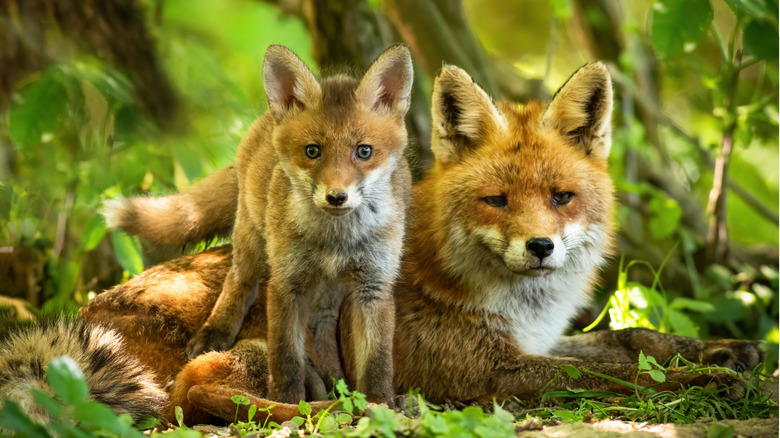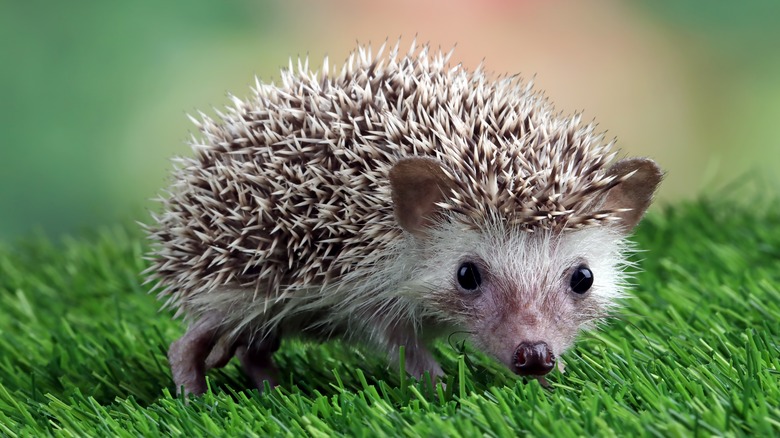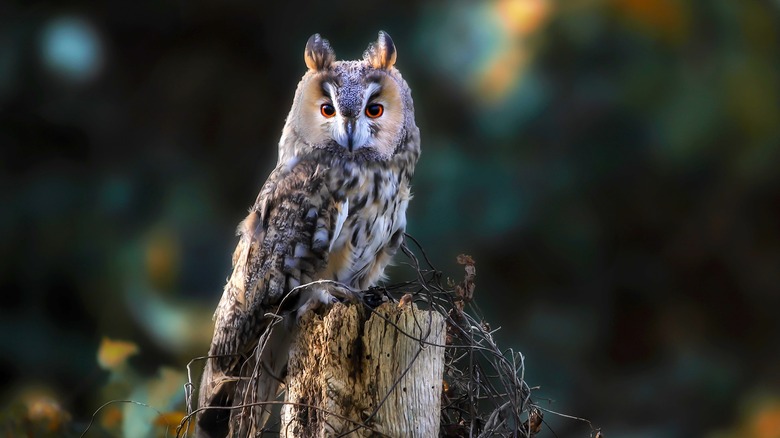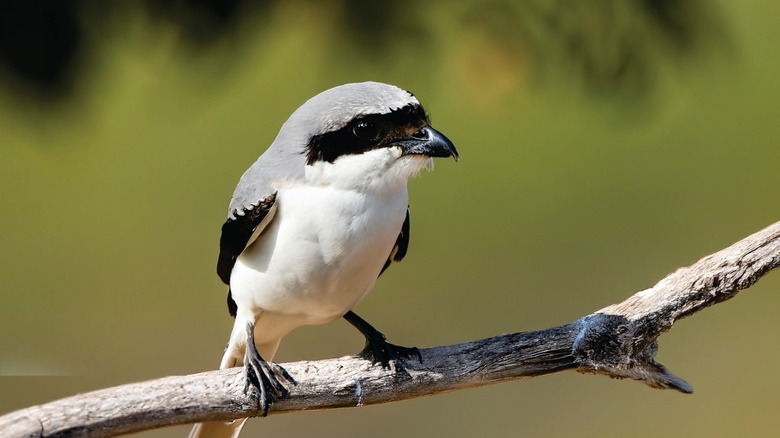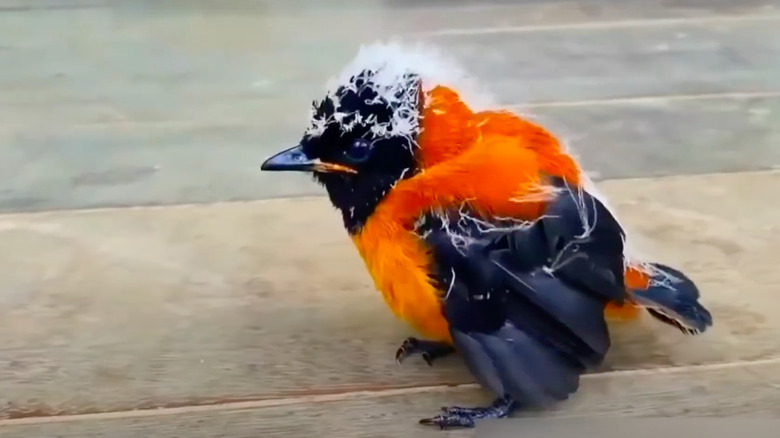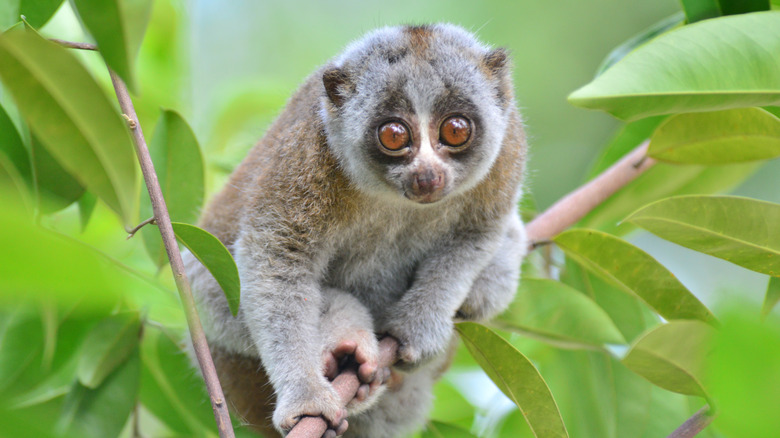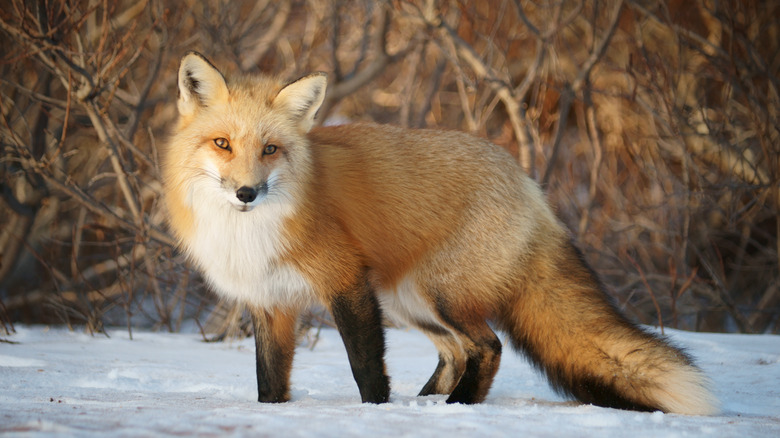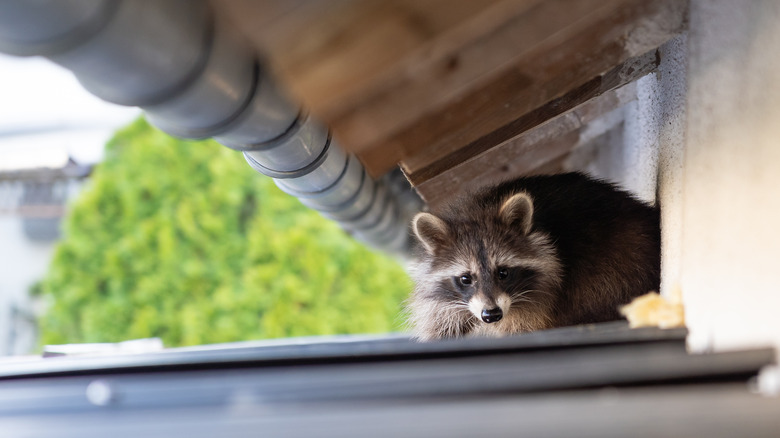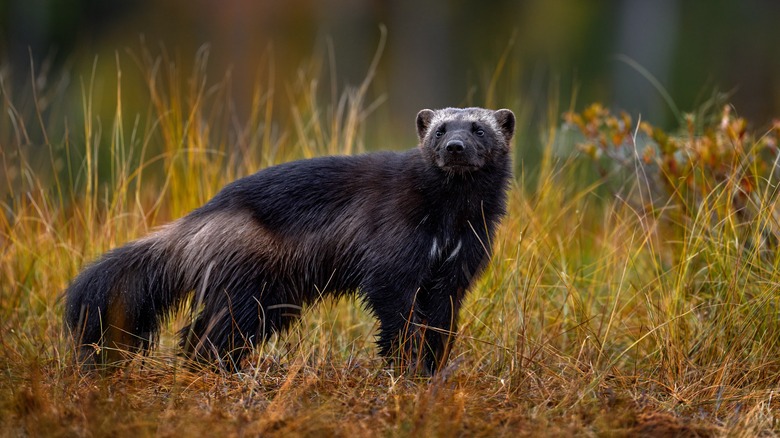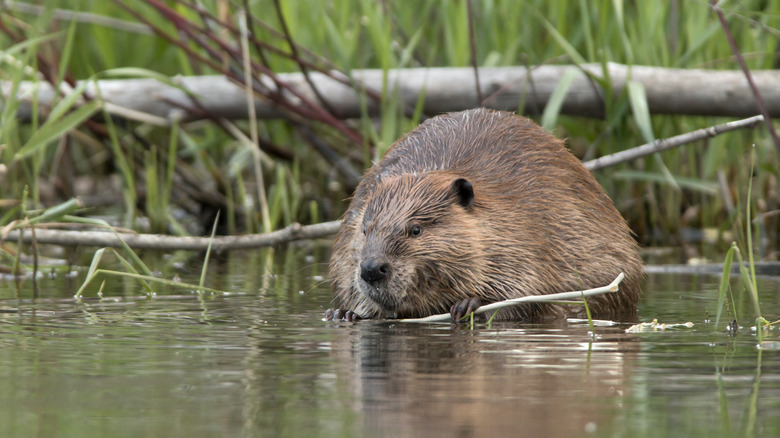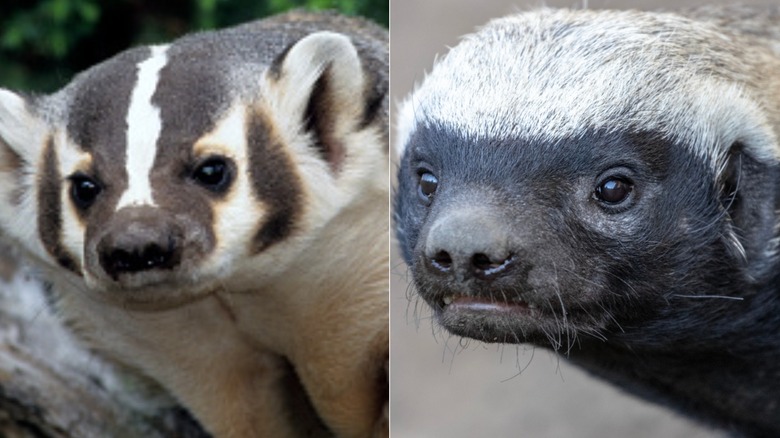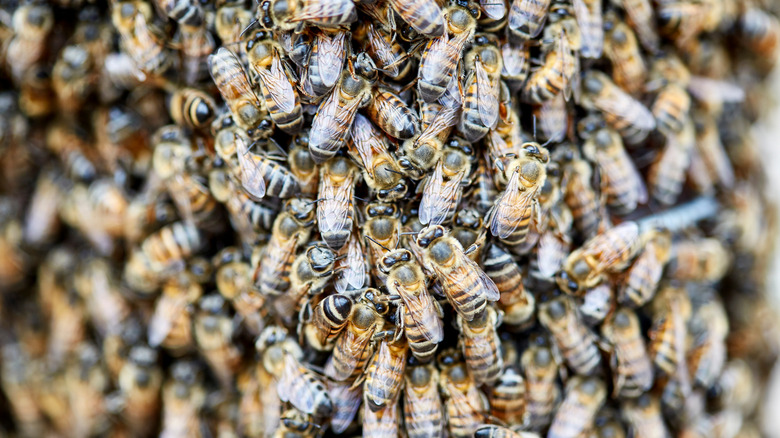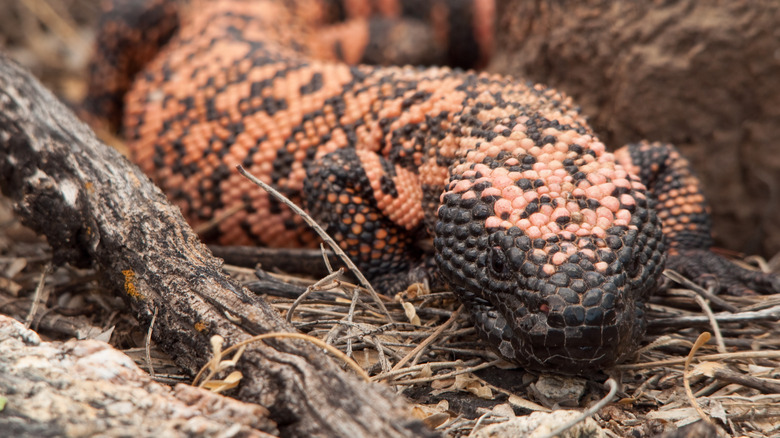Tiny Animals You'll Encounter On A Hike That Are As Cute As They Are Dangerous
There is truth to what Shakespeare says: "Though she be but little, she is fierce." This quote from "A Midsummer Night's Dream" is often attributed to women who are small in stature, but large in spirit, and potentially quite dangerous. It's a line that has been paraphrased multiple times before, and it will be again as we examine some of our smaller friends in the animal kingdom.
No matter where you are on the globe, you are bound to encounter a number of different creatures while out hiking. Whether it is a boreal forest or a tropical jungle, the world is inhabited by animals, many of which could actually pose a significant danger to you. And though most might be more concerned by the appearance of a bear than a hedgehog, we should still be wary of the danger small creatures present.
It doesn't matter how cute you think any of the creatures on this list are. They are still more dangerous than they look. Some are dangerous by their very nature. Some are only dangerous when cornered or frightened. All of them, however, have the capability of inflicting varying degrees of damage on their opponents, and have even been known to kill people in certain circumstances. So, get past the cuteness factor here, folks. These are tiny animals you might encounter on a hike that are as cute as they are dangerous.
Hedgehog
Really? You're starting this list off with hedgehogs? Yes, actually, we are. Consistently ranked among the cutest animals in the world, wild hedgehogs do actually present some cause for concern. Now, you're right, the vast majority of hedgehogs are not in any way aggressive towards humans. On the contrary, if a hedgehog feels safe, they have no qualms whatsoever about being picked up, pet, and snuggled. However, you need to remember that nature does not create any animal, no matter how small, to be defenseless.
The quills of a hedgehog are that defense mechanism. When they are feeling threatened, those spikes will stand straight up and the hedgehog will form themselves into a tight, defensive ball. The idea is to puncture their attacker and ward them off with a few sharp jabs. And seeing as adult hedgehogs are covered in an average of roughly 7,000 spines, it's an excellent guard against attack.
So, should you come across one in the woods and scare it sufficiently enough for it to curl into its ball of spiked armor, don't try to pick it up. Depending on how soft or sensitive your skin is, the hedgehog spikes have the potential to puncture your skin with some pretty nasty slivers that should be disinfected right away. Yes, while the hedgehog certainly won't be mauling you to death, it can still cause some aggravating damage, making it more dangerous than it outwardly appears.
Owl
Though not necessarily tiny, at least depending on the species, owls are nevertheless considered to be among the coolest (and cutest) looking creatures in the entire world. Barn owls, with their heart-shaped faces and big eyes, or burrowing owls, with their flat heads and fast-moving talons, are among the more recognizable smaller owls. There is reason to be concerned, however. Owls are birds of prey, which means they are equipped with natural features that can make them dangerous.
You are not likely to encounter an owl during sunlight hours. These nocturnal hunters use their razor sharp talons and beaks to tear apart mice, rats, voles, and other small creatures in the forest or barnyard. Though less than twice the size of an average human, owls will attack if provoked. Joggers and hikers have been set upon by owls for accidentally invading the bird's space. As all owls are naturally protective of their young, they have no issue using the tools nature gave them to attack people they see as a threat.
Those same talons and beaks that are used for dispatching mice can very easily slice through your skin like a hot knife through butter. Any lacerations you receive from an owl require immediate disinfection and a trip to the emergency room to get them stitched. Apart from their aggressive attack, owls can also carry any number of bacteria and diseases that could be potentially fatal to humans.
Shrike
Some serial killers have been dubbed with nicknames more tame than the bird we're about to discuss. Shrikes, also nicknamed "butcher birds" appear to be nothing more than an average songbird. However, if you've ever watched one attack and devour its prey, you will know that these birds are far from cute and tweeting. Shrikes attack and impale their prey both with their beaks and on the sharp thorns of acacia trees. The impalement not only finishes the prey off, but provides the shrike with the means to devour its prey without it moving around.
While they cannot devour humans in this way purely because of their size, shrikes do not have qualms about attacking people. Their beaks are incredibly sharp and strong for their size. They will be absolutely ferocious and savage in their attacks. The intensity will likely leave you with several lacerations, likely across your face and arms.
Though they are very territorial birds, it does not take much for the shrike to attack. We wouldn't go so far as to say that looking at one the wrong way will set it off, but you never know. Shrikes have been known to attack without much reason and are extremely territorial. So you'd do well to steer clear of these birds if you're hiking in the dry, warmer areas that they like.
Hooded Pitohui
There are many friendly-looking creatures throughout the world that are actually quite dangerous, though not always in the way you might think. The hooded pitohui is one such animal. Unlike some of its other feathered cousins, such as the owl and shrike, there is nothing outwardly threatening about this bird. On the contrary, the hooded pitohui is actually exceptionally beautiful and colorful. However, it is this vibrancy that should alert you to its danger.
You see, the feathers of a hooded pitohui are toxic. How did they get this way? Well, the myeloid beetles that the hooded pitohuis feed on create batrachotoxins, which excrete from the feathers of the bird, and make them extremely poisonous. In fact, it is the same toxin that makes the poison dart frog so dangerous, but we'll get more into that in a little while.
Simply touching a hooded pitohui can spread the venomous toxin throughout the body, causing burns and stinging on the skin. Consumption of the toxin can lead to paralysis, cardiac arrest, and even death. While hooded pitohuis are not overly territorial or confrontational, they will certainly scratch and peck if you venture too close to them. Therefore, it is best to stay away from these birds, who proliferate the jungles of Papua New Guinea.
Slow Loris
Settled in the jungles of Malaysia lives the absolutely adorable slow loris. An extremely small primate, no larger than the average squirrel, the slow loris is distinguished by its enormous eyes set against an incredibly compact face. On the cuteness meter, it is up there with the likes of the chinchilla and koala bear. However, be warned. These little monkeys pack a bite, literally, that could leave you paralyzed or even dead.
Slow loris are one of the few known venomous mammals. They produce a toxic oil that secretes from their armpits, which makes its way to the mouth via the primate's self-cleaning regimen. The toxin is not fully ingested by the creature, meaning that it hangs around inside of their mouth, creating a venomous saliva. When a slow loris bites a person or predator, it can cause severe anaphylactic shock which, if not treated with immediacy, will lead to death.
If that weren't terrifying enough, the bite of the slow loris is powerful enough to bite through to the bone, as well as rot and melt flesh away from other primates. This frightening effect hasn't been seen in any human examples, but we wager it is possible seeing as we are long-distance cousins. This venomous bite is the chief reason why slow loris' are not allowed to be household pets.
Red Fox
We want to point out that the common red fox is not naturally aggressive towards humans. On the contrary, if you happen across one on a trail, it will very likely high tail it in the opposite direction. However, though their red fur and adorable faces make them among the cuter wild canines, a red fox can still present a good amount of danger, especially if it is rabid.
A red fox is more likely to attack your backyard chicken flock or even your pet dog than it is to attack you. When it is rabid, however, its behavior can become quite erratic. Its natural inclination to bite is exacerbated by the rabies disease active within their nervous system. This means that an encounter with a rabid fox is going to increase the likelihood of a bite.
If left untreated, a rabies bite can be fatal to humans. So, despite their naturally shy behavior, you should always be wary of a fox. If it is exhibiting any kind of strange behavior, such as seizures, or is confrontational towards you, back away immediately. The last thing you need is to deal with rabies when you just wanted to go for a peaceful walk in the woods.
Raccoons
Though they are not much larger than a common house cat, raccoons nevertheless present a significant danger to body and property. Like the red fox, raccoons are a major concern for the spreading of rabies and other diseases within the United States. Though their coloration makes the raccoon seem cute and lovable, they will cause damage if they are properly provoked. Just look at what they do to your trash bins.
Raccoons are strong and stocky animals. They have very sharp teeth and claws that they are in no way afraid to use. Mainly defensive fighters, raccoons pose a significant threat to children and pets who approach them without caution. Anyone who corners a raccoon, particularly one that is presenting itself as rabid or is protecting its young, will get attacked. They will use their teeth and claws to bite and scratch wherever they are able to make contact.
Any attack from a raccoon needs to end with a trip to the emergency room. Even if the animal in question was not rabid, there are still plenty of diseases that they can pass along. Make sure that all wounds get disinfected, and that you receive a vaccine for rabies when you visit the ER. Untreated rabies will result in death, which is certainly not something any of us want from being attacked by a small animal.
Wolverine
Wolverines are a cross between a small bear and a large skunk. They're not particularly large, no more so than the average dog. What they are, however, is dangerous. Just as in "X-Men", real wolverines are not to be messed with. With jaws strong enough to bite down to the marrow and an attitude fierce enough to ward off the likes of bears and moose, a wolverine is not the kind of animal you want to provoke.
Like a lot of other wild animals, wolverines are generally fearful of humans. That does not mean, however, that they will not attack one. Wolverines should not be approached, especially if there are young ones nearby. Those jaws and claws will sink into your skin faster than you can even realize it is happening. And that same ferocity that wards off bears will be set upon you with full fury.
That said, there are no documented cases of wolverines attacking people. This does not mean that they have not happened, or have the possibility of happening. They just haven't been recorded. If you happen across some in the wild, it is always best to err on the side of caution and set off in the opposite direction.
Beaver
Though they are more at home swimming in the water and building some of the coolest animal shelters around, beavers are another small animal whose cuteness is a front for potential danger. Like so many other animals, the common beaver is naturally wary of humans. They prefer, instead, to keep to themselves and to their dams as opposed to confronting mankind. Still, they will attack if they feel threatened or become disoriented. And an attack has the potential to be lethal.
According to USA Today, a man in Belarus was killed by a beaver while he was out fishing. The beaver's long teeth, which are designed for chewing through the trunks of trees, did their work on the poor man's leg. He approached the beaver, simply trying to take a picture of it, and the critter attacked, biting deep into the man's leg and severing an artery. He bled out and died as a result.
Beavers also have the potential to become aggressive due to the presence of rabies. They've been known to attack out of the blue if people get too close, using their teeth and powerful tails to inflict damage upon their opponents. As you are far more likely to come across these guys while you're out hiking than some of the other animals on this list, steer clear of beavers if you see some.
Badger
Whether you are taking a walk in the woods, or trekking across the Kalahari in Africa, you need to steer clear of badgers. Whether they are American, European, or the legendary honey badger makes no difference. Their cute appearances mask the great danger these animals can pose when threatened. Badgers are no slouches when it comes to defense. They do not normally attack out of aggression, but when they do decide it's time to brawl, they attack with ferocity.
Honey badgers, in particular, are known for taking on animals three times their size, such as lions and crocodiles — and winning. All badgers are equipped with long, powerful claws and teeth, making them a compact fighting package. American and European badgers can easily take on the likes of coyotes and wolves without so much as a second thought.
Keeping those things in mind, do you think it would be wise to cross one? Any animal that can take on the creatures we just listed does present the potential for significant danger to a human's well being. And while badgers are notoriously elusive, coming across one and making it feel threatened is a surefire way to force it into attack.
Honey Bees
It is a matter of personal opinion whether or not you find honey bees to be cute. Regardless, there is no question about the danger they pose. Though danger levels vary between species of bee, know that, depending on whether or not you are allergic, the sting of a bee has the potential to inflict a good amount of pain, and even death, on a human being.
There are certain types of bees you need to be more wary of than others, particularly if you are hiking in California, Africa, or the wilds of Brazil. Africanized honey bees, also known as killer bees, have been responsible for over 1,000 human deaths since they were introduced to Brazil as an invasive species. Victims of the Africanized bee receive up to ten times the stings of a normal European honey bee. Most people, even those who are allergic, are able to recover from the latter. The former, however, will kill you.
Bee nests are relatively easy to spot in the wild, so steer clear of them. The temptation for wild honey should never put you in a situation that could get you killed. Unless you are an expert beekeeper, you need to stay away from these buzzing bugs. If you get on the wrong side of them, Africanized honey bees will chase you for miles just to get a sting in.
Poison Dart Frog
Another animal whose cuteness is a matter of personal perspective, the vibrant colors of a poison dart frog should tell you everything you need to know about their danger levels. Occupying the Amazon Rainforest in South America, these colorful amphibians are known for the toxic secretions that come out of their skin. The color is an indication to potential predators about the toxicity of the frog, and they will be an indication to you as well if you happen to cross one and think about touching it.
Not all poison dart frogs have the ability to kill people, but the Golden Poison Dart Frog is the one that you really need to watch out for. It produces a highly concentrated and specific amount of batrachotoxin that has the capability of killing 10 people (via Understory Enterprises). And that is just from a single frog. Like the hooded pitohui, the toxin of the dart frog can be passed along to people either through touching the frog, or ingesting the toxin. Historically, the golden poison dart frogs have been used as a means of poisoning darts used by Native tribes as defensive weapons.
These frogs are highly localized to the Amazon Rainforest, so your likelihood of encountering them is small, unless you happen to be exploring this famous jungle in South America.
Gila Monster
Finally, we have the gila monster. This small, stocky, and speckled lizard is considered adorable in certain circles. Its orange and black mottled scales, and long winding tail give the gila monster the appearance of some kind of alien. An elusive, desert-dwelling creature, the gila monster is not one for human contact. However, when it feels threatened, the gila monster can deliver one of the most powerful, and painful bites in the animal kingdom.
The toxin that exudes from the venomous bite has the same power as that of a western diamondback rattlesnake. Though it is not likely to kill you, you will be needing a trip to the hospital. The bite can cause severe pain, illness, dizziness, vomiting, increased heart rate, and weak limbs. If you happen to come across one, which is somewhat likely the deserts of southern California, it's best to admire its wacky looks from a distance rather than approaching it.
Keeping to yourself while hiking is a matter of common sense. Encounters with wild animals, while on the rarer side, do still happen. And even if an animal is cute, like the ones on this list, it is still best never to approach one. You could end up on a trip to the hospital, or even dead if things go south.
